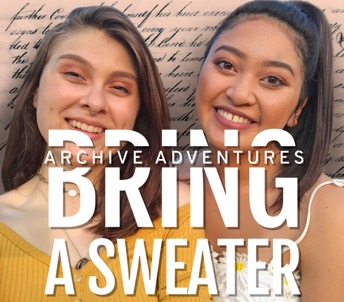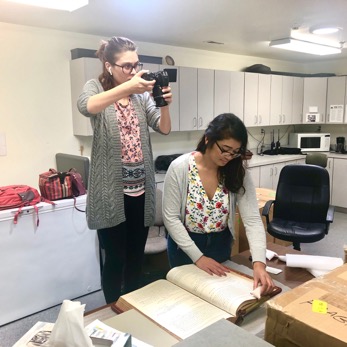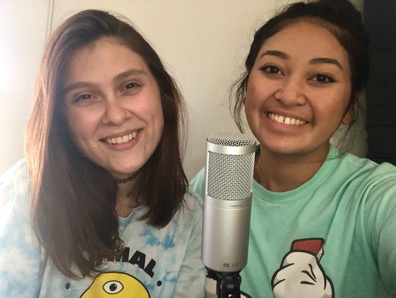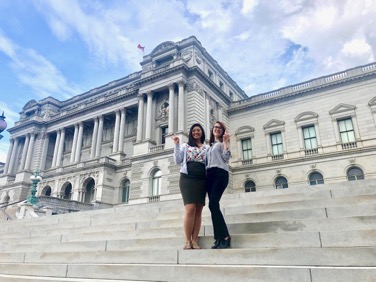Bring A Sweater: Podcasting as public history
07 January 2020 – Lady Marie Bulilan and Alaina Scapicchio

The title image for Bring a Sweater: Archive Adventures, 2019. Photo credit: Alaina Scapicchio Design credit: Chris Bulilan
What’s the right thing to wear to the Manuscript Reading Room in the Library of Congress? That question might seem trivial to those who have done archival research before, but it was a fairly big one for us as two undergraduates setting off on our first journey as research assistants. Emailing and asking the few professional historians we knew began to yield suggestions. Since archives are often quite chilly, one of the first bits of advice was to bring a sweater when heading out to do research. We quickly realized that if we had these sorts of questions, then others in our position did too. In this state of confusion, we determined that this was an opportunity to share our experiences as new researchers with a wider audience—to help our peers and others to understand not only what can be found in historical archives, but what it is like to work in them for the first time. We decided that we wanted an accessible and engaging medium to share our experiences with people off-campus and outside the classroom. The answer was obvious: a podcast series. As regular consumers of the medium we were aware of its benefits and rising popularity. This was a chance to move from being podcast listeners to being podcast creators. The title was just as obvious as the idea itself: Bring A Sweater. So, armed with a vision of how to reach a wide audience and with our University of South Florida Professor Philip Levy serving as producer and sound engineer, we began both our venture into the world of podcasting.
We were going to spend the summer of 2019 working with Professor Levy on a new National Park Service Historic Resource Study for the George Washington Birthplace National Monument. It was our first chance to do the work of professional historians in places we knew only by name—repositories such as The Library of Congress, The National Archives, and the Archives Center at the Smithsonian National Museum of American History. Most of our work, however, occurred in the Westmoreland County Courthouse, which houses the surviving seventeenth- and eighteenth-century county records on shelves full of the large gray bindings you see us working with below. In each of these archives, we spent many hours photographing, databasing, and transcribing documents in order to gain a greater understanding of the Washingtons and their surrounding community.

The authors photographing documents at the George Washington Birthplace National Monument, 2019.
Photo credit: Philip Levy.
A common theme throughout our archival experience was “trial and error.” Each new archive presented new challenges to navigate because they all have different rules and organizational styles. We became aware of the basic procedures and etiquette relatively quickly, but each day was different from the last and we learned to adapt quickly to every environment. During our workdays, we would share a notebook in which we could document our experiences, anecdotes, and helpful tricks we learned along the way. At first, we were unsure if there would be enough content to fill up our podcast episodes, but as the days progressed we were worried that our episodes would be too long. Explaining the idiosyncrasies of each archive and what they demanded from researchers presented us with the challenge of keeping the episodes concise.
Podcast production proved to be a trial and error process as well. We began recording the podcast episodes in our humble apartment, one corner of which we converted into a makeshift studio made up of a spare mattress, a foam topper, draped blankets to dampen background noise, and a stack of books for our single mic stand. Once our setup was complete and we mastered the technical side, which took some practice, it was time to develop our “podcast voices.” This process was a bit rocky starting out and getting comfortable on the microphone definitely took a few episodes—but soon we were completely relaxed in front of the mic, as you can see below. At first Professor Levy helped guide the conversations, but in time he stepped back and we took over. We quickly learned how to create natural pauses in our conversation which would make editing easier rather than trying to fill the twenty minutes with sound. After working through minor teething pains, we found podcasting to be fairly straightforward and manageable. We wanted the podcast to feel less formal than other educational podcasts, but still full of useful information. Over time, we felt more comfortable letting our personalities shine through—making the microphone all the more inviting. As we began thinking of more episode topics, our excitement grew with the thought of being able to tell everyone about our work and what we were learning.

The authors behind the mic on their last day of recording, 2019. Photo credit: Lady Marie Bulilan.
History podcasts offer a readily available platform that is less formal than writing a publication and more accessible than having individual conversations with those interested in a given topic. Podcasts allow sharing knowledge or sparking discussion in a comfortable and casual manner and bring both historians and curious listeners to the table. Creating a podcast gave us, as new researchers, a way to reflect on our experiences right away. In this tech-savvy and fast-paced generation, people are usually on the go. Many listeners have reached out to us to say that they enjoyed listening at work or during a commute and expressed how they often felt they were sitting at the recording table laughing and learning with us. We also recognized the value of using social media, specifically on our Instagram account @bringasweater_podcast, as an avenue to interact with our listeners, historical societies, and other podcasters. As Marla Miller noted in her History@Work post, “Advocating for archivists,” social media acts as a channel to hasten the process of communication, allowing for organizations and individuals to weigh in on events and discussions while they are relevant. Both podcasting and social media allow historians to connect with their audience in ways that were previously unimaginable. Formally published works will always maintain their value, but less formal conversations are occurring daily and historians should be a part of them. In many ways, history podcasting has become an innovative form of public history that deserves to be more widely utilized.

The authors pictured outside the Library of Congress showing their USF Bull pride by using the hand gesture of their mascot at the University of South Florida, 2019. Photo credit: Philip Levy.
Although our summer research came to an end, our podcast Bring a Sweater is far from reaching its final episode. As we move into new historical adventures, we plan to bring our podcast along with us to document all that the world of public history has to offer. We discovered that one of the most valuable aspects of podcasting is that episodes or clips can be recorded during research or in the field. In our first season, we recorded various episodes in our apartment studio and on-site, in places such as the George Washington Birthplace and Mount Vernon. As part of this ongoing project to inspire others to leap into the world of professional public history, we plan to record more episodes at the NCPH 2020 annual meeting. It is our sincere hope that our podcast will encourage historians of our generation to explore the many tools at their disposal as they create and share their own new histories.
~Lady Marie Bulilan received her Bachelor’s degree in History at the University of South Florida in May of 2019. Focusing on American History and Museum Studies, she hopes to one day work for a museum like the Smithsonian to bring more light to the Asian American experience.
~Alaina Scapicchio is an undergraduate history major at the University of South Florida with a focus on American history and memorialization. She will graduate in December of 2019 and will be applying to public history graduate programs this year.



